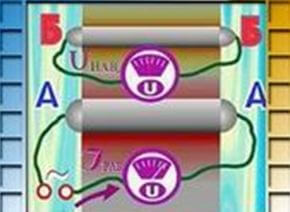What is induced voltage and why is it dangerous?
Causes
Induced voltage occurs on the overhead power transmission line (VL), which has been brought out for repair and is de-energized, due to the influence of an electromagnetic field located in the immediate vicinity of a working electrical installation or another VL that is under voltage. Thus, the overhead line, which runs parallel to the disconnected line, induces a third-party potential, which poses a significant danger to the maintenance repair team. The value of the induced voltage in the wire varies depending on the length of the section where the overhead lines run in parallel, the load current and the magnitude of the operating voltage, the remoteness of the phase wires, and meteorological conditions. The potential that is induced on the overhead line combines two types of exposure - the electromagnetic and electrostatic components:
- The electromagnetic part appears under the influence of a magnetic field arising from the flow of current through a nearby overhead line. A distinctive feature of this component is that when grounding, even in several places of the line, it does not change its value. The only thing that can be changed using grounding is the location of the zero potential point.
- The electrostatic part, in contrast to the electromagnetic, is eliminated by grounding the line at its ends and at the place of work. It is possible to reduce the magnitude of the induced voltage by installing grounding at least at a single point of the overhead line.
Let's take a closer look at what it is - induced voltage and the nature of its occurrence. To understand how it appears, we turn to the photo, which shows the conductor:
There is a conductor indicated in the picture as AA. When an alternating current flows through it, an electromagnetic field is created, the intensity of which decreases with distance from the conductor (a decrease in the brightness of the color can be seen in the image). The pulsations of the electromagnetic field also change with a change in the direction and magnitude of the current. When any other conductor enters the field, an induced voltage is induced in it. The picture below shows the conductors with connected measuring devices for determining the voltage value:
What is considered hazardous to personnel? It is believed that if the induced voltage is present on a disconnected overhead line and its value does not exceed 25 V, then repair measures are carried out using conventional protective equipment.If the safe value is exceeded, special protective equipment should be used and technical measures should be taken to ensure the required degree of protection against the dangerous effects of the induced potential. Such safety measures can be grounding at the beginning and end of the line, wire cut, installation of grounding in the areas of overhead lines.
Learn about what electrical protective devices are used in installations above 1000 voltsYou can from our article!
What is the danger of the phenomenon?
Induced voltage can be considered more dangerous and insidious, unlike the worker, due to the fact that protective equipment does not react to it in any way. For example, if repair personnel fall under it, the employee will be exposed to hazardous exposure until released from his influence. But if a person is affected by operating voltage, then protection is triggered and automatic shutdown occurs due to a short circuit.
Speaking of short circuit (short circuit). When short circuit occurs in the working line, there is a tip to a disconnected overhead line and a multiple excess of current, which, of course, affects the personnel engaged in repairing the disconnected overhead line. The consequences can be very deplorable - from severe burns, to the flow of current through vital organs with their defeat, up to a fatal outcome. Therefore, it is not necessary to neglect safety rules when working on disconnected overhead lines.
What to do if a person gets under induced voltage? How to get rid of its effects? It is necessary to eliminate the flow of current through the human body. To do this, you need to connect the hazardous part of the electrical installation with the "ground", throwing grounding on it.
A tip in the apartment
Apart from overhead lines and electrical installations, induced voltage can also occur in an apartment and in a private house in a 220 V network. The so-called “pick-up” appears in the cable, laid again next to the wire through which current flows. As an example, let us cite a situation when a faint glow appears on the diode bulbs when the switch is off. This is due to the fact that next to the wire that feeds the lamps, a conductor with a phase conductor is laid. And the action of the electromagnetic field has not been canceled. From here a small tip arises, the magnitude of which is enough to “illuminate” the LEDs.
Another case is a tip in the socket. It arises if occurred zero wire break. Then, when measuring with the indicator on the terminals of the outlet, we get two phases. But in fact, the phase wire as it was, will remain, and the "second phase" will disappear as soon as the neutral wire is reconnected.
You can familiarize yourself with an example of the dangerous effects of interference on the video:
So we examined what induced voltage is, what is the danger of this phenomenon and what protective measures need to be taken in order to protect personnel from electric shock. We hope that the information provided was understandable and useful for you!
Surely you do not know:











